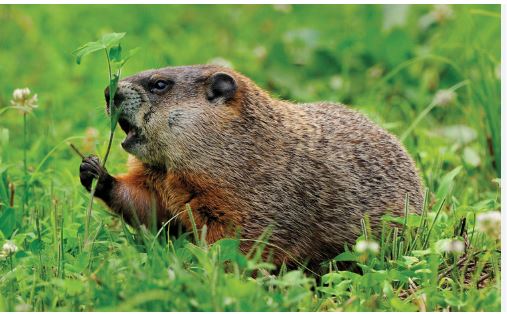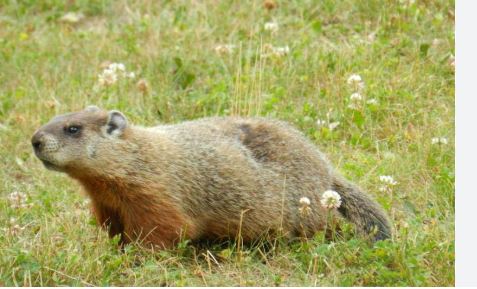
Groundhogs are large rodents native to North America, known for their burrowing habits and hibernation. Often found in open fields, forest edges, and suburban areas, they thrive in diverse lowland habitats. Their stocky bodies, short tails, and strong claws make them adept diggers, creating extensive underground tunnels.
These animals are solitary, except during mating season, and spend much of their lives in burrows with separate chambers for sleeping and waste. Their burrowing aerates soil, benefiting ecosystems, but can damage crops and structures, leading to conflicts with farmers and gardeners. They are skilled climbers and swimmers, aiding predator evasion.
Their diet is herbivorous, consisting of grasses, clover, berries, and garden plants. This feeding behavior supports their hibernation, during which they rely on stored fat for months. Their ability to consume a wide variety of vegetation contributes to their adaptability across regions.
Hibernation is a hallmark trait, lasting up to six months in colder climates. They emerge in early spring to mate and forage, with their activity cycle influencing local ecosystems. This deep winter dormancy distinguishes them from many other rodents.
Culturally, they are celebrated in traditions like Groundhog Day, where their emergence is linked to weather folklore. Despite inaccurate predictions, this event highlights their role as seasonal symbols. Their behaviors and charm make them a focus for wildlife enthusiasts.
Conservation-wise, most populations are stable, but habitat loss in specific regions threatens some groups. Protecting their habitats ensures their ecological contributions, like soil aeration, continue. Their resilience and adaptability keep them thriving across their range.

Species of Groundhogs
Common Groundhog (Marmota monax)
The Common Groundhog, or woodchuck, is the most widespread marmot in North America, found from the eastern United States to Canada and parts of Alaska. This solitary rodent, measuring 16–26 inches and weighing 4–13 pounds, has brownish-gray fur and powerful digging claws. Thriving in meadows, forest edges, and suburban yards, it builds complex burrows and hibernates for up to six months. Its herbivorous diet includes grasses, clover, and crops, often making it a pest for farmers but a key soil aerator.
Eastern Groundhog (Marmota monax monax)
The Eastern Groundhog, a regional population of Marmota monax, is prevalent across the eastern U.S. and Canada. Slightly smaller, with grizzled brown fur and a short tail, it inhabits wooded areas and pastures. An adept climber and swimmer, it escapes predators by scaling trees. It hibernates through winter and feeds on alfalfa and vegetables, impacting agriculture. Its burrows enhance soil health, supporting ecosystems despite its pest status.
Yellow-Bellied Marmot (Marmota flaviventris)
The Yellow-Bellied Marmot, often confused with groundhogs, is found in western North America, from Alaska to New Mexico. Larger than Marmota monax, it has yellow-brown belly fur and a stockier build. Living in social colonies in rocky, mountainous areas like the Rockies, it hibernates for up to eight months and eats grasses, flowers, and seeds. Its social behavior and alpine habitat set it apart from the solitary, lowland groundhog.
4. Vancouver Island Marmot (Marmota vancouverensis)
The Vancouver Island Marmot, critically endangered, is native only to Vancouver Island, British Columbia. With rich brown fur and a white chest patch, it lives in alpine meadows and hibernates for seven months. Unlike the solitary Common Groundhog, it forms small colonies. With fewer than 200 individuals due to habitat loss and predation, conservation efforts are critical to save this rare marmot.
Hoary Marmot (Marmota caligata)
The Hoary Marmot, found in western Canada and the northwestern U.S., inhabits rocky alpine slopes. Its frosty, grayish-white fur gives it its name, and it lives in small social groups, unlike the solitary groundhog. Hibernating up to eight months, it feeds on alpine plants and communicates with loud whistles. Its high-altitude lifestyle contrasts with the groundhog’s lowland preference, but both share burrowing habits.
Alaska Marmot (Marmota broweri)
The Alaska Marmot, native to Alaska’s Brooks Range and other northern mountainous regions, is a lesser-known marmot species. Smaller than the Common Groundhog, it has dark brown fur with lighter patches and lives in rocky tundra and alpine meadows. Social in small colonies, it hibernates for up to eight months, feeding on grasses and sedges during the short summer. Its remote habitat limits human interaction, keeping its population stable but understudied.
Olympic Marmot (Marmota olympus)
Endemic to Washington’s Olympic Peninsula, the Olympic Marmot is a unique marmot species with golden-brown fur and a stocky build. It inhabits subalpine meadows and talus slopes, living in colonies and hibernating for seven to eight months. Feeding on grasses, flowers, and roots, it plays a key role in alpine ecosystems. Its restricted range makes it vulnerable to climate change, but conservation efforts help maintain its population.
Gray Marmot (Marmota baibacina)
The Gray Marmot, found in parts of Canada’s Yukon and British Columbia, as well as Central Asia, is a large marmot species with grizzled gray fur. Living in colonies in grassy alpine and subalpine zones, it hibernates for long periods and feeds on herbs and grasses. Unlike the solitary Common Groundhog, its social structure involves complex interactions. Its North American populations are less studied, but habitat changes pose potential risks.
Long-Tailed Marmot (Marmota caudata)
The Long-Tailed Marmot, found in parts of British Columbia and Central Asia, is distinguished by its notably long tail and reddish-brown fur. It inhabits high-altitude meadows and rocky slopes, living in small colonies. Hibernating for up to seven months, it feeds on alpine grasses and herbs. Its remote range in North America keeps it less known, but it shares the groundhog’s burrowing habits, contributing to soil turnover.
Himalayan Marmot (Marmota himalayana)
The Himalayan Marmot, present in high-altitude regions of western Canada and Asia, thrives in alpine grasslands and rocky terrains. Its thick, brownish fur and social colony structure contrast with the solitary groundhog. Hibernating for extended periods, it feeds on grasses and roots. In North America, its populations are limited to extreme northwestern regions, and climate change threatens its high-altitude habitats.
Tarbagan Marmot (Marmota sibirica)
The Tarbagan Marmot, found in parts of Canada’s Yukon and across Asia, is a robust marmot with coarse, brownish-gray fur. Living in colonies in grassy steppes and mountains, it hibernates for six to eight months and feeds on grasses and forbs. Unlike the groundhog, it exhibits strong social behaviors. Its North American range is limited, and habitat disturbance poses potential risks to its populations.
Black-Capped Marmot (Marmota camtschatica)
The Black-Capped Marmot, native to Alaska and parts of Siberia, is a smaller marmot with dark fur and a distinctive black cap on its head. It inhabits tundra and alpine meadows, living in social groups and hibernating for up to eight months. Feeding on grasses and sedges, it shares the groundhog’s burrowing habits but prefers colder, higher elevations. Its remote habitat helps maintain stable populations, though climate change is a growing concern.